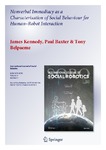Nonverbal Immediacy as a Characterisation of Social Behaviour for Human–Robot Interaction
| dc.contributor.author | Kennedy, J | |
| dc.contributor.author | Baxter, P | |
| dc.contributor.author | Belpaeme, T | |
| dc.date.accessioned | 2017-03-22T21:20:34Z | |
| dc.date.issued | 2017-01 | |
| dc.identifier.issn | 1875-4791 | |
| dc.identifier.issn | 1875-4805 | |
| dc.identifier.uri | http://hdl.handle.net/10026.1/8671 | |
| dc.description.abstract |
An increasing amount of research has started to explore the impact of robot social behaviour on the outcome of a goal for a human interaction partner, such as cognitive learning gains. However, it remains unclear from what principles the social behaviour for such robots should be derived. Human models are often used, but in this paper an alternative approach is proposed. First, the concept of nonverbal immediacy from the communication literature is introduced, with a focus on how it can provide a characterisation of social behaviour, and the subsequent outcomes of such behaviour. A literature review is conducted to explore the impact on learning of the social cues which form the nonverbal immediacy measure. This leads to the production of a series of guidelines for social robot behaviour. The resulting behaviour is evaluated in a more general context, where both children and adults judge the immediacy of humans and robots in a similar manner, and their recall of a short story is tested. Children recall more of the story when the robot is more immediate, which demonstrates an effect predicted by the literature. This study provides validation for the application of nonverbal immediacy to child–robot interaction. It is proposed that nonverbal immediacy measures could be used as a means of characterising robot social behaviour for human–robot interaction. | |
| dc.format.extent | 109-128 | |
| dc.language | en | |
| dc.language.iso | en | |
| dc.publisher | Springer Science and Business Media LLC | |
| dc.subject | Nonverbal immediacy | |
| dc.subject | Social behaviour | |
| dc.subject | Robots for education | |
| dc.subject | Social cues | |
| dc.subject | Human-robot interaction | |
| dc.title | Nonverbal Immediacy as a Characterisation of Social Behaviour for Human–Robot Interaction | |
| dc.type | journal-article | |
| dc.type | Article | |
| plymouth.issue | 1 | |
| plymouth.volume | 9 | |
| plymouth.publication-status | Published online | |
| plymouth.journal | International Journal of Social Robotics | |
| dc.identifier.doi | 10.1007/s12369-016-0378-3 | |
| plymouth.organisational-group | /Plymouth | |
| plymouth.organisational-group | /Plymouth/Faculty of Science and Engineering | |
| plymouth.organisational-group | /Plymouth/Research Groups | |
| plymouth.organisational-group | /Plymouth/Research Groups/Marine Institute | |
| plymouth.organisational-group | /Plymouth/Users by role | |
| dcterms.dateAccepted | 2016-08-30 | |
| dc.rights.embargodate | 2017-9-16 | |
| dc.identifier.eissn | 1875-4805 | |
| dc.rights.embargoperiod | 12 months | |
| rioxxterms.versionofrecord | 10.1007/s12369-016-0378-3 | |
| rioxxterms.licenseref.uri | http://www.rioxx.net/licenses/under-embargo-all-rights-reserved | |
| rioxxterms.licenseref.startdate | 2017-01 | |
| rioxxterms.type | Journal Article/Review |


